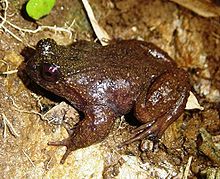
The Esociformes is a small order of freshwater ray-finned fish, with two families, Umbridae and Esocidae. The pikes of genus Esox give the order its name.
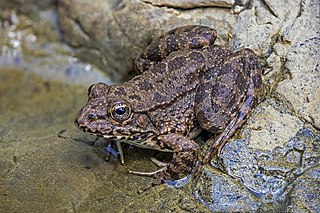
True frogs is the common name for the frog family Ranidae. They have the widest distribution of any frog family. They are abundant throughout most of the world, occurring on all continents except Antarctica. The true frogs are present in North America, northern South America, Europe, Africa, and Asia. The Asian range extends across the East Indies to New Guinea and a single species, the Australian wood frog, has spread into the far north of Australia.

The Neobatrachia are a suborder of the Anura, the order of frogs and toads.

The vocal sac is the flexible membrane of skin possessed by most male frogs and toads. The purpose of the vocal sac is usually as an amplification of their mating or advertisement call. The presence or development of the vocal sac is one way of externally determining the sex of a frog or toad in many species; taking frogs as an example;

Darwin’s frog, also called the Southern Darwin's frog, is a species of Chilean/Argentinian frog of the family Rhinodermatidae. It was discovered by Charles Darwin during his voyage on HMS Beagle. on a trip to Chile. In 1841, French zoologist André Marie Constant Duméril and his assistant Gabriel Bibron described and named Darwin's frog. The diet of R. darwinii consists mostly of herbivore invertebrates. R. darwinii is currently classified as an endangered species by the International Union for Conservation of Nature.
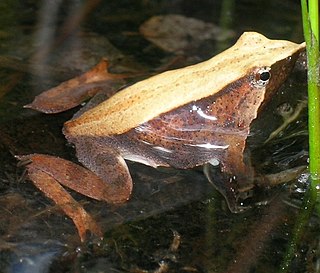
Rhinoderma, commonly known as Darwin's frogs, is a genus of small frogs found in Chile and adjacent parts of Argentina. It has just two species, of which the Chile Darwin's frog is highly endangered or may already be extinct. The better-known Darwin's frog is endangered.

The Rhacophoridae are a family of frogs that occur in tropical sub-Saharan Africa, South India and Sri Lanka, Japan, northeastern India to eastern China and Taiwan, south through the Philippines and Greater Sundas, and Sulawesi. They are commonly known as shrub frogs, or more ambiguously as "moss frogs" or "bush frogs". Some Rhacophoridae are called "tree frogs". Among the most spectacular members of this family are numerous "flying frogs".

Heleophrynidae is a family of frogs, commonly known as ghost frogs. They are thought to be the most basal group in the Neobatrachia. The family consists of two genera, Heleophryne and Hadromophryne, with seven species. Ghost frogs live in swift-moving mountain streams in South Africa. The common name of "ghost frogs" may have been coined because of their occurrence in Skeleton Gorge.

Insuetophrynus is a monotypic genus of frogs in the family Rhinodermatidae. The sole species is Insuetophrynus acarpicus, also known as Barrio's frog. It is endemic to Chile and only known from few localities on the Valdivian Coast Range between Chanchán in the Los Ríos Region in the south and Queule and Colequal Alto in the north; the fourth locality is Mehuín, which is the type locality. The altitudinal range is 50–486 m (164–1,594 ft) asl.

The Chile Darwin's frog, also called the northern Darwin's frog, is a possibly extinct frog, and one of only two members of the family Rhinodermatidae. It is endemic to central Chile.

Hyloidea is a superfamily of frogs. Hyloidea accounts for 54% of all living anuran species. The superfamily Hyloidea branched off from its closest relative, the Australobatrachia, during the mid-Cretaceous. The fossil evidence found during the Cretaceous-Paleogene extinction event could not determine the effects upon the frogs, due to the lack of fossils. Increased forestation erupted after this extinction, possibly leading to more arboreal adaptations of these anurans to be best suited for this habitat.
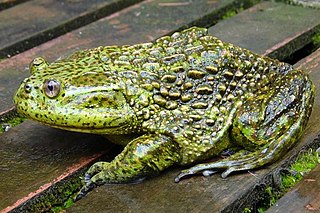
Calyptocephalella is a genus of frogs in the family Calyptocephalellidae. It is represented by a single living species, Calyptocephalella gayi, commonly known as the helmeted water toad, Chilean helmeted bull frog, or wide-mouthed toad. Additionally, there are a few extinct species that are only known from Late Cretaceous and Paleogene fossil remains from Patagonia in South America and the Antarctic Peninsula. The helmeted water toad living today is aquatic to semi-aquatic, and found in deep ponds and reservoirs in central Chile and possibly adjacent west-central Argentina.
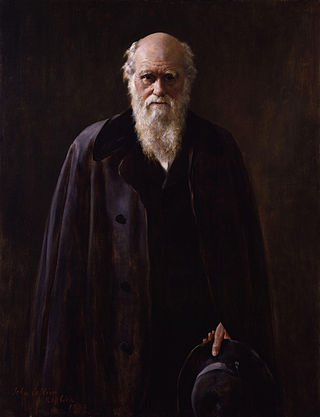
Commemoration of Charles Darwin began with geographical features named after Darwin while he was still on the Beagle survey voyage, continued after his return with the naming of species he had collected, and extended further with his increasing fame. Many geographical features, species and institutions bear his name. Interest in his work has led to scholarship and publications, nicknamed the Darwin Industry, and his life is remembered in fiction, film and TV productions as well as in numerous biographies. Darwin Day has become an annual event, and in 2009 there were worldwide celebrations to mark the bicentenary of Darwin's birth and the 150th anniversary of the publication of On the Origin of Species.

Pelodryadinae, also known as Australian treefrogs, is a subfamily of frogs found in the region of Australia and New Guinea, and have also been introduced to New Caledonia, Guam, New Zealand, and Vanuatu.

Phyllomedusinae is a subfamily of hylid tree frogs found in the Neotropics commonly called leaf frogs. Formerly, they were often considered as their own family, Phyllomedusidae.

The Calyptocephalellidae are a family of toads found in Chile containing two living genera, Calyptocephalella and Telmatobufo.

Afrobatrachia is clade of frogs in the suborder Neobatrachia, all of which are restricted to Africa, including some species in Madagascar and the Seychelles. It is the sister group to the clade Natatanura, which contains all other members of Ranoidea aside from Microhylidae

Myobatrachoidea is a superfamily of frogs. It contains two families, both of which are found in Australia, New Guinea, and the Aru Islands. Some sources group these two families into a single family Myobatrachidae.

Australobatrachia is a clade of frogs in the suborder Neobatrachia. It comprises three families of frogs with a Gondwanan distribution, being known from Chile, Australia, and New Guinea. Together, they form the sister group to the superfamily Hyloidea.

Sooglossoidea is a superfamily of frogs. It contains only two highly divergent families consisting of three genera with two species each, one family being found in southwestern India and the other in the Seychelles.
